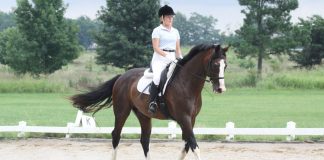
It can be tempting to saddle up your horse on the first warm day of spring and go for a long ride. However, assuming your horse has been out of work all winter, he’s not only lost muscle tone, but also tendon and ligament strength. Bringing him back gradually before placing rigorous athletic demands on him is the best way to prevent injuries all season long.
“The first thing I do is get my horse checked out by my vet,” advises Miles. “Usually the only time people get their horses looked at is during a pre-purchase exam, or when something has already gone wrong. Have the vet out to deworm, vaccinate and do a lameness evaluation with flexion tests. This can give you a heads-up for things you may need to watch for.”
Likewise, Miles feels dental concerns are all too often overlooked and can contribute to performance problems. “Have a good equine practitioner look at your horse’s teeth,” says Miles. “Your [regular] vet can do a great basic float, but a specialist can do more performance-type work.”
When you’ve gotten the all-clear to start back into your riding routine, give your horse enough time to prepare for your athletic goals. “Plan for it to take four to eight weeks for your horse to return to the level of fitness he was at before your break, depending on how long it was. If your horse was off more than three months, it may take even longer than that.

Walking is an important part of a conditioning program.
“Walking is a big part of my program,” continues Miles. Since slow work is so important at the beginning, take your watch along. “During the first week, I start with a 15- to 20-minute daily walk under tack, increasing it by five minutes per day until I’m walking for 45 minutes,” says Miles. “At this point, I start to introduce a three-minute trot. I increase trotting by two to three minutes each day until I am trotting for 15 minutes.”
However, Miles advises that you shouldn’t go by your watch alone, since every horse responds differently to conditioning depending on his age, breed, et cetera. “The most important thing is to listen to your horse,” she cautions. “If he’s really huffing and puffing or sweating, stay at the same level, and be sure to watch his legs carefully for any signs of heat or swelling. Cardiovascular fitness improves the quickest, then the muscles, and the tendons and ligaments take the longest, which is why I stress lots of walking [to strengthen tendons and ligaments].
“When your horse can trot comfortably for 15 minutes with a quick recovery, you can add the canter,” Miles continues. “Start with a two-minute interval, and eventually add a second and third short interval of cantering before increasing the duration.”
Although it’s more interesting to do conditioning work out in the field, Miles says that it’s not necessary. “All of this can be done in the arena if you don’t have access to fields. It may be boring to walk around the ring, so go out and walk around the barn!”
As you work on conditioning, keep in mind that the slower you start off your season, the more likely your horse is to stay sound all year long. While it may not be as much fun as getting in the saddle and going for a gallop, the long-term payoff is well worth it.
Liked this article? Here are others on conditioning your horse:
Start Your Horse’s Spring Training
Safe Conditioning
Hill Work for Conditioning
Horse Illustrated Managing Editor HOLLY CACCAMISE is an avid eventer.
This article originally appeared in the April 2011 issue of Horse Illustrated. Click here to subscribe.






Starting slow is best for both you and your horse.
cool